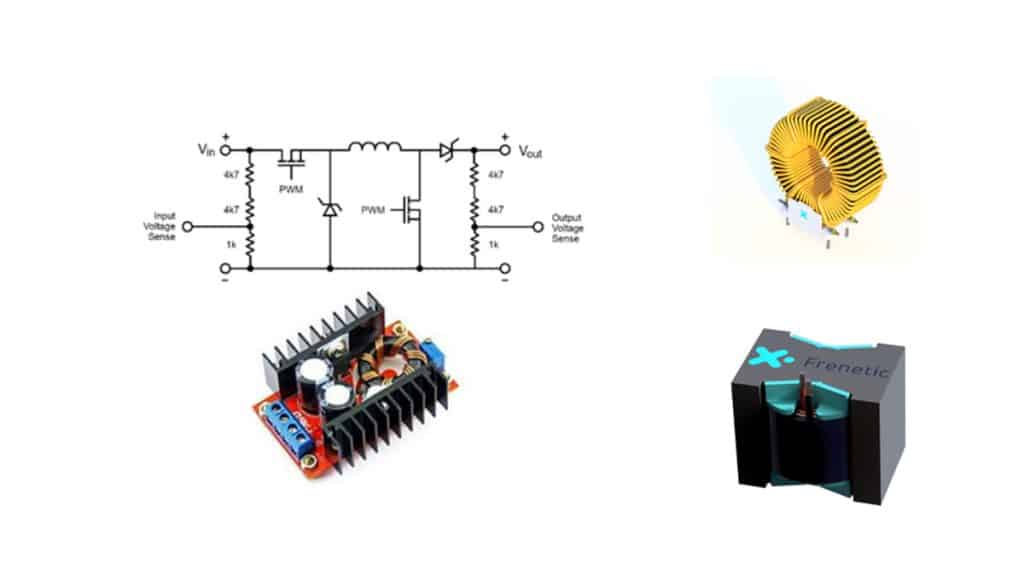This article is based on blog written by Pablo Blázquez, Frenetic power electronics engineer that compares inductor and transformer solutions for Buck-Boost Converter and discusses benefits of Off-the-Shelf vs Customized solutions.
As technology continues to advance, demands for compact and efficient Power Converters are on the rise.
Magnetics, such as Inductors and Transformers, are the ones that help achieve this goal by significantly contributing to the miniaturization of Converters.
In Power Converters, Inductors are commonly used to smooth out the current, reduce ripple, and store energy that can be released when needed.
Transformers are instrumental in changing voltage levels, stepping up or stepping down as required.
Buck-Boost Converter Off-the-Shelf vs. Customized Solutions
To show the impact of Magnetics on size reduction, let’s take into consideration the Buck-Boost Converter. This topology is widely used for voltage regulation, capable of both stepping up and stepping down the input voltage.
Many engineers opt for off-the-shelf Magnetics components due to their convenience and availability. However, when it comes to achieving the smallest possible size for a Converter, these components might fall short.
- Size: off-the-shelf components are designed to meet general requirements, resulting in compromises. The physical dimensions of these components may not perfectly align with the space constraints of a specific application.
- Time: acquiring off-the-shelf components is quick, but integrating them into a design might take additional time. Modifications to the circuitry to accommodate these components could be necessary.
- Cost: off-the-shelf components are cost-effective in terms of initial investment, but they might not be the most economical choice in the long run if they lead to suboptimal performance or if additional modifications are needed.
For projects where size is a critical factor, investing in customized solutions for Magnetic components could be a game-changer.
- Size: tailoring Inductors and Transformers to the exact specifications of the application allows for a more efficient use of space. This can result in a significant reduction in the overall size of the Converter.
- Time: while designing and manufacturing custom Magnetics may take a bit longer, the time invested is often justified by the improved performance and size reduction achieved.
- Cost: customization may involve higher upfront costs, but the long-term benefits, such as improved efficiency and reduced footprint, can make it a cost-effective choice over the converter’s lifecycle.
Buck-Boost Converter Case Study
Let’s consider now a practical scenario involving a Buck-Boost Converter for a portable electronic device. First, let’s imagine an Off-the-Shelf scenario, where engineers choose off-the-shelf Inductors and Transformers for the Buck-Boost Converter. While these components meet the basic requirements, the Converter’s size is larger than desired due to the compromise on form factor.
Then we move to a Customized Solution scenario. In this case, engineers decide to invest in custom Inductors and Transformers precisely tailored to the specifications of the application. The result is a Buck-Boost Converter that not only meets all performance criteria, but is also significantly smaller in size.
Let’s explore now on the comparative data. For Off-the-Shelf components:
- Size: 100mm x 80mm x 20mm
- Efficiency: 90%
- Cost: $10 per unit
- Design and Integration Time: 2 weeks
While, for the customized solution:
- Size: 60mm x 40mm x 15mm
- Efficiency: 95%
- Cost: $15 per unit
- Design and Integration Time: 4 weeks
Conclusion
While off-the-shelf Magnetics components provide a quick and cost-effective solution, they might not be the optimal choice when size is a critical factor. Customized Inductors and Transformers, despite requiring more time and upfront investment, offer a tailored approach that can significantly reduce the overall size of the Converter while improving performance.
As technology continues to advance, the importance of Magnetics in Power Electronics cannot be overstated. The choice between off-the-shelf and customized solutions ultimately depends on the specific requirements of the application, with an eye on achieving the perfect balance between size, efficiency, and cost.
